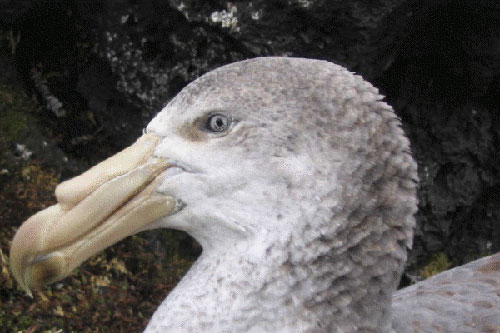Both primary and secondary poisoning of non-target species are risks that face pest eradication programmes and require amelioration (e.g. Wanless et al. 2010). For example, spreading poison baits on islands is often carried out during winter months when most summer-breeding seabirds are absent at sea.
On Australia's sub-Antarctic Macquarie Island an attempt to rid the island of introduced rabbits and rodents by spreading poison bait by helicopter was aborted this year after long runs of non-flying weather (click here). Following a review of the programme, it is now been decided to make a new attempt in 2011 (click here).
Although only a small part of the island was baited this year, on-going foot patrols by island field staff have up to 19 November found a total of 883 corpses of six bird species, thought to have died either by primary poisoning (by direct ingestion of bait) or by secondary poisoning (by feeding on poisoned carcasses). A total of 293 (33.1%) of the birds found dead and showing characteristic signs of haemorrhaging were ACAP-listed Northern Giant Petrels Macronectes halli. This figure is 8.0% of the island's 2010/11 annual breeding population of 1829 pairs.
Only 12 Southern Giant Petrel M. giganteus corpses were found although the island's breeding population of Southerns is larger than that of Northerns (Patterson et al. 2008, http://www.acap.aq/acap-species). Further, of a sample of 10 dead Northern Giant Petrels collected on the island and autopsied back in Tasmania, nine were males. It seems likely that the giant petrels died from secondary, rather than primary poisoning, as on a couple of occasions they were seen to be feeding on dead rabbits. In addition in repeated bait trials during 2006-2008 no Northern Giant Petrels showed any interest when presented with (non-poison) bait pellets.
The observed differences in mortality rates are thought to be a reflection of differences in foraging behaviour between the sibling species and between the sexes that have been observed at Macquarie and at other sub-Antarctic islands where both species breed (Johnstone 1977, Hunter 1983, Hunter & Brooke 1992, González-Solís et al. 2000, de Bruyn et al. 2007).
The experience gained this year will be used to make changes to procedures during the 2011 bait drop. Intensive searches for and removal or burial of rabbit and bird corpses during and immediately after the aerial-baiting phase will result in less food for giant petrels, and hopefully a reduced mortality from secondary poisoning. In addition, the feasibility of using alternate food sources to divert non-target species from poisoned corpses will be investigated.
In addition, collection of bait pellets in the immediate vicinity of nests of the Wandering Albatross Diomedea exulans (as was carried out this year) will reduce the slight risks of chicks dying from primary poisoning.
Regular news of the pest eradication project can be obtained from its newsletter Macquarie Dispatch.

References:
De Bruyn, P.J.N., Cooper, J., Bester, M.N. & Tosh, C.A. 2007. The importance of land-based prey for sympatrically breeding giant petrels at sub-Antarctic Marion Island. Antarctic Science 19: 25-30.
González-Solís, J., Croxall, J.P. & Wood, A.G. 2000. Foraging partitioning between giant petrels Macronectes spp. and its relationship with breeding population changes at Bird Island, South Georgia. Marine Ecology Progress Series 204: 279-288.
Hunter, S. 1983. The food and feeding ecology of giant petrels Macronectes halli and M. giganteus at South Georgia. Journal of Zoology, London 200: 521-538.
Hunter, S. & Brooke, M.deL. 1992. The diet of giant petrels Macronectes spp. at Marion Island, southern Indian Ocean. Colonial Waterbirds 15: 56-65.
Johnstone, G.W. 1977. Comparative feeding ecology of the giant petrels Macronectes giganteus (Gmelin) and M. halli (Mathews). In: Llano, G.A. (Ed.). Adaptations within Antarctic Ecosystems. Proceedings of the Third SCAR Symposium on Antarctic Biology. Washington, D.C.: Smithsonian Institution. pp. 647-668.
Patterson, D.L., Woehler, E.J., Croxall, J.P., Cooper, J., Poncet, S., Peter, H.-U., Hunter, S. & Fraser, W.R. 2008. Breeding distribution and population status of the Northern Giant Petrel Macronectes halli and the Southern Giant Petrel M. giganteus. Marine Ornithology 36: 115-125 + on-line appendix.
Wanless, R.M., Cooper, J., Slabber, M. & Ryan, P.G. 2010. Risk assessment of terrestrially foraging birds on Marion and Gough Islands to primary and secondary poisoning by rodenticides. Wildlife Research 37: 524-530.
With thanks to Ian Hay, Australian Antarctic Division and Keith Springer, Manager, Macquarie Island Pest Eradication Programme for information.
John Cooper, ACAP Information Officer, 23 November 2010

 English
English  Français
Français  Español
Español